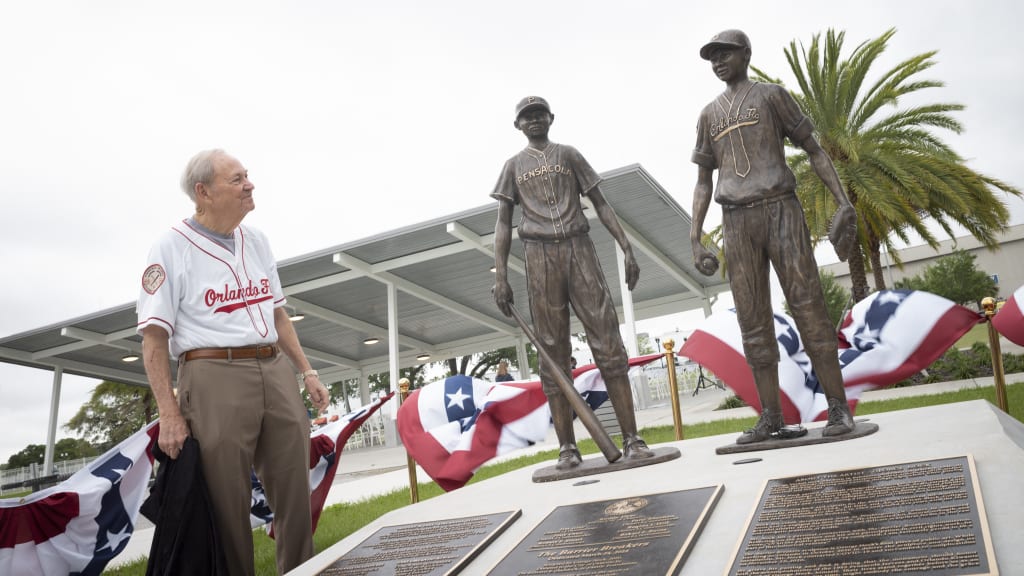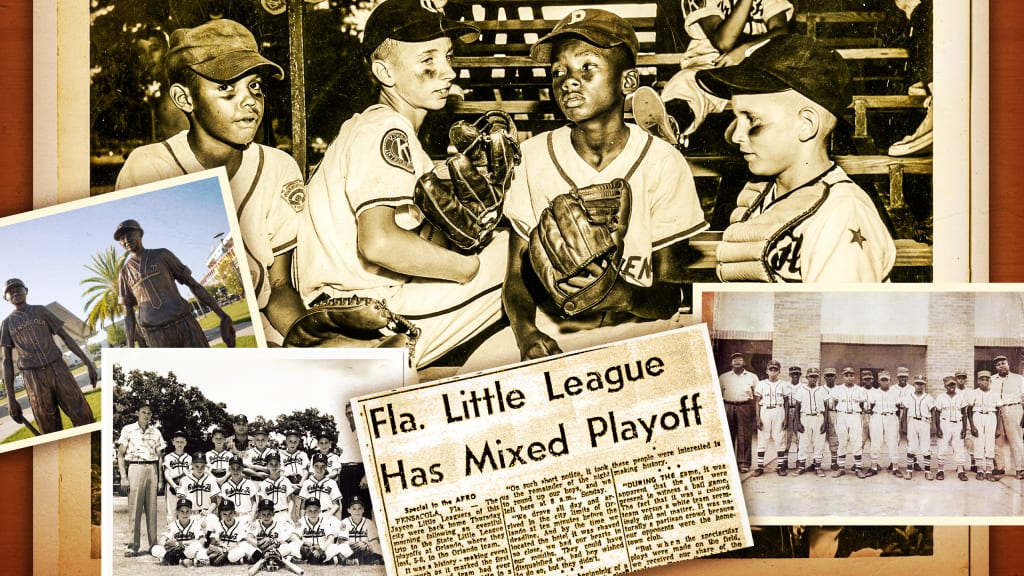
There is no baseball field at Lake Lorna Doone Park today. But baseball history was made there 67 years ago.
Although this diamond to the west of downtown Orlando didn't last forever, the legacy of what occurred in 1955 is immortalized by a monument that was unveiled at the park this past spring. It's entitled "The Barrier Breakers" and features a bronze sculpture of two boys in baseball uniforms. One has "Pensacola" across the front of his jersey while the other's reads "Orlando Fla."
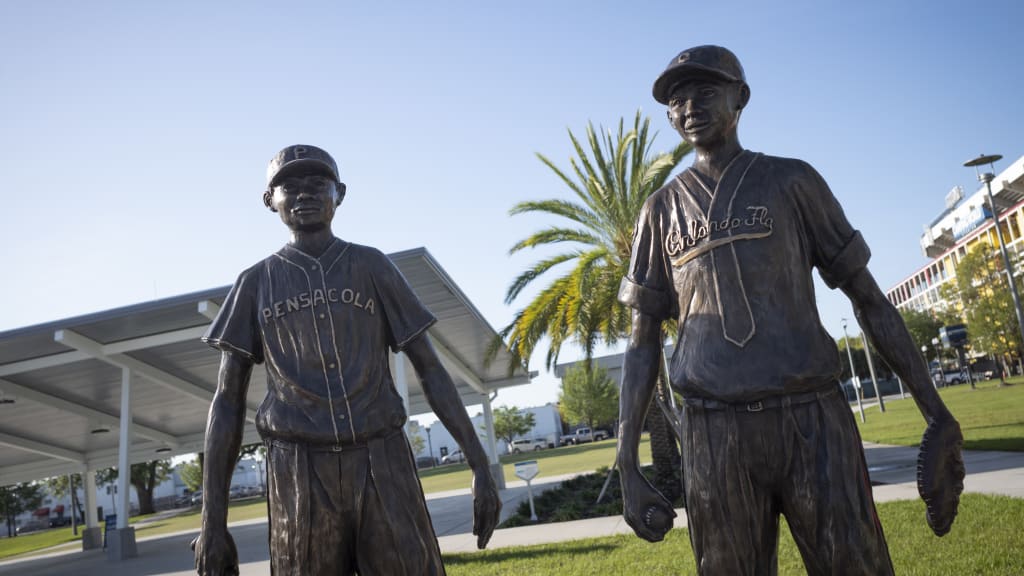
"It’s just bringing back all of that memory," said Orlando Kiwanis first baseman Stewart Hall, who is white.
"I thought about the memories of what that hallowed ground holds," said Pensacola Jaycees second baseman Freddie Augustine, who is Black.
Both men, now nearing 80, were present at the unveiling on a rainy day in March to laugh, hug and recollect when they truly broke barriers.
A little more than a year following the Brown v. Board Supreme Court decision that outlawed segregation in schools, and a few months before the Montgomery bus boycott, two teams of 12-year-old-boys met on a dusty field in Orlando to play the first integrated Little League game in the Deep South.
Hall and Augustine had a lot in common as kids. They both grew up in Florida. They both rooted for the Brooklyn Dodgers. And they both played baseball any chance they got. Separated by about 450 miles, however, they came from very different worlds.
Hall remembers the 1950s as "a dream time" to grow up, and Orlando as "a dream city." Baseball was a constant. Playing it, talking about it, trading baseball cards. The sport was "in our blood as far back as I can remember," he said.
Augustine had a similar infatuation with America's pastime. But baseball served as more than just a way to pass the time. It was an outlet, an escape from the hardships of living in the Deep South during the time of Jim Crow laws. Although Augustine remembers playing sports with white kids while growing up in Pensacola, sanctioned Little League contests of the sort in the Deep South were unprecedented.
Augustine got his shot at Little League ball in 1955, when the physical education instructor at his junior high school said he should join one of the four teams in the all-Black Pensacola Jaycees Little League, which was founded a year prior. By season's end, Augustine was selected for the All-Star team.
In late July, the other All-Star teams in the area gathered to take part in the district tournament, the first step toward the Little League World Series in Williamsport, Pa. However, the director of Little League in Pensacola’s district ruled the Jaycees ineligible on the grounds that its Little League was not franchised and was thereby illegal. Ignoring the Jaycees, the district’s five all-white teams went forth with a tournament to see who would advance to the state tournament in Orlando.
However, on Aug. 3, Little League Baseball officials objected to the exclusion, stating that Jaycees Little League was established, and the team must be included in any competition for the Northwest Florida district title, or else all tournament games would be invalid.
Rather than play the Jaycees, the other clubs refused to take the field against an all-Black squad. Little League Baseball declared on the evening of Aug. 6 that the Pensacola Jaycees were district champions via forfeit.
This left Augustine and his teammates with one chief emotion: excitement.
They were headed to Orlando and thrilled to be traveling solely because of baseball.
“We knew what racism was all about. But here we are going to play baseball, and as 12-year-old children, we never got a chance to go out of town unless we were going to grandmama’s house,” Augustine said. “And here we get a chance at 12 years old to go play a baseball game? Man, it’s awesome.”
There wasn’t much time to celebrate.
The Jaycees were told to report to Orlando's San Juan Hotel by 8 p.m. the next day in order to participate in the tournament draw. Making that 450-mile journey wasn’t an easy feat in 1955, a time before major highways ran through the state. Players, coaches and team officials piled into three cars and departed from the Booker T. Washington Junior High School gym at 8 a.m. They didn’t have time to make many stops on the way and there frankly weren’t many places they could stop.
Augustine recalls that there were five service stations along the route, and only one would allow the Jaycees to use their bathrooms and drink from their water fountains.
The team reached the San Juan Hotel with mere minutes to spare. As manager Fred Hicks told the Afro-American Newspaper later that month, the Jaycees arrived so close to the deadline, “They could have disqualified us had they wished to do so.”
Instead, the tournament draw went off without incident. The Jaycees received a first-round bye in the six-team field, meaning their first game was scheduled for Aug. 9.
Whether they would be allowed to step on the field at what was then known as Optimist Park, however, remained very much in question.
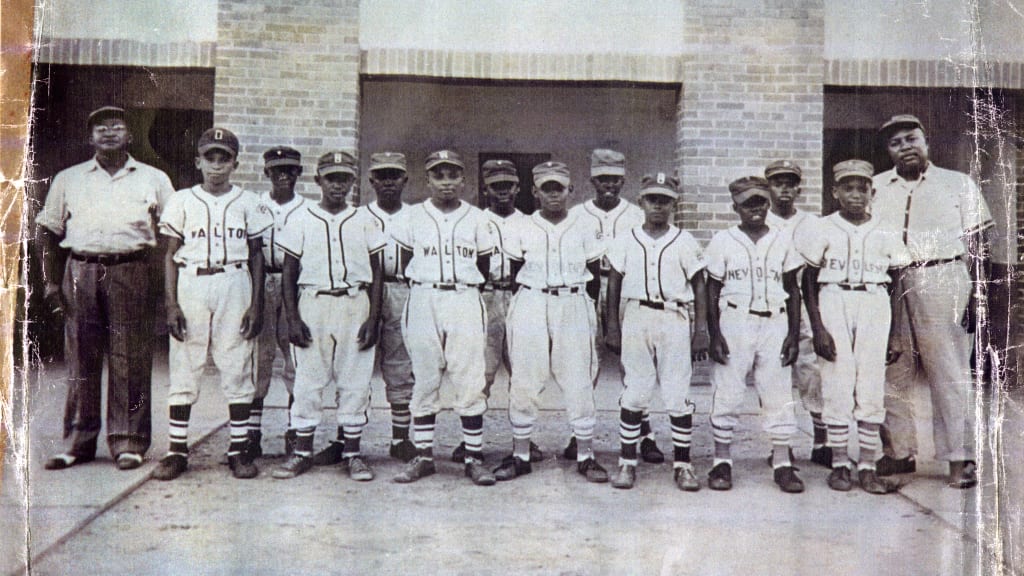
Danny Rivenbark and Johnny Lane were two of the on-field leaders on the 1955 Orlando Kiwanis Little League All-Star team. Hall said the duo “were as good as any pitchers I’ve ever seen in Little League Baseball.” Yet it was Hall who clubbed a two-run homer in the district title game and punched the team’s ticket to the state tournament in their home city.
The Kiwanis opened state tourney play on Aug. 8 versus Tallahassee, with the winner scheduled to face the Jaycees in the semifinals. While it was unknown if Orlando would play the Jaycees, the parents of the Tallahassee players “were 100 percent against their boys taking the field against a Negro team,” according to the Orlando Sentinel.
Rivenbark turned that into a non-issue as he tossed a one-hit shutout in an 8-0 victory. The Kiwanis and Jaycees were now scheduled to meet in the semis at 5 p.m the following day. Efforts were being made to keep it from happening.
Prior to the start of the tournament, Orlando recreation director Tom Starling informed his counterpart in Pensacola that it was city policy not to allow white teams to play against Black teams and that he would seek an injunction from the city attorney’s office.
The office responded on the day of Orlando's first game, with assistant city attorney Donald Senterfitt stating that the problem "is a purely internal affair of the Little League tournament officials and is not one in which the city of Orlando is directly involved. … I don’t see where we have any authority in this case.” This was followed by an emergency meeting of the Orlando City Council on the morning of the Kiwanis-Jaycees game at the behest of city commissioners. However, the council unanimously adopted the legal opinion that the city had no authority.
Instead, the authority belonged largely to a group of 12-year-old boys from Orlando. They discussed the matter with their parents and coaches following the Tallahassee win.
“I do remember them asking,” Hall said. “I think we all just looked at each other and said, ‘Well, let’s play.’
“I don’t remember anyone having anything negative to say about playing the game.”
The Kiwanis players were all-in. Their manager, Dwight DeVane, was not. With nothing to keep the game from proceeding, DeVane quit. Assistant coach Mel Rivenbark, Danny’s father, would assume the head role, and Bob Gould, who worked in the city recreation department, became the assistant coach.
“I don’t like the idea of playing the game personally, but I feel like I owe it to the boys,” Mel Rivenbark told the Orlando Evening Star.
When the Evening Star reached out to DeVane for a comment on his resignation, he said: “If you are a Southerner, live like a Southerner.”
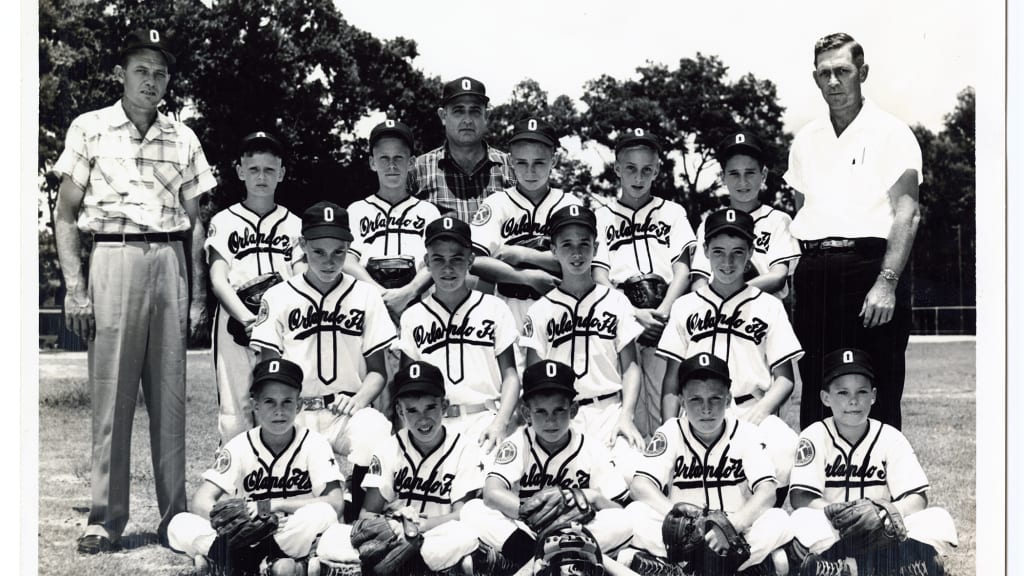
As Hall and his teammates made their way to the old, unmanicured playing field at Optimist Park on Aug. 9, this semifinal seemed like just another baseball game.
To the Jaycees and the town of Orlando, it was something more.
“Our coaches told us that we were probably making history,” Augustine said.
That aspect wasn’t lost on the city as shops reportedly closed early, and residents stood in crowds extending down each foul line. Other fans filled up the segregated stands behind each dugout; the Black fans sat behind the Jaycees’ first-base dugout while white fans were positioned behind the Kiwanis' third-base dugout. Most estimates put the attendance at between 750 and 1,000.
“The place was packed out,” Hall said. “It was two- or three-deep along the fences. We never had (more than) 50 or 75, 100 people at a game, but for this one, there was a really big turnout from the city.”
The crowd rooted for the home team most of all, but they also reportedly cheered the Jaycees when they came out for batting practice and whenever one of their players made a good play.
“That was a real educated crowd. I mean, for us to be Black and those guys were white; there was no namecalling or nothing,” Augustine said.
The game itself did not match the level of anticipation surrounding it. Robert East, the Jaycees’ star pitcher who would go on to play a year of Minor League ball in the Washington Senators’ system, struggled with his control from the start and surrendered a two-run homer to Danny Rivenbark to put Pensacola in an early hole.
That’s all the support Lane would really need, as the Orlando hurler struck out 13 batters in the six-inning game.
“I guess I must have been about 4-foot-10, but Johnny looked like he was about 6 feet," said Augustine, who struck out to end the game. “When he delivered that ball, he had that curveball working that day.”
A line-drive hit by Pesslean Brye was all the offense Pensacola would muster as Orlando triumphed, 5-0, to advance to the state championship game.
East may have been impacted by a knot that appeared on his pitching arm following a scuffle with a teammate the night before the game. Or, as Jaycees assistant coach Nathaniel Black suggested to the Sentinel, nerves may have gotten to the Pensacola youngsters.
The cause of the loss was simple to Augustine: “The fact of the matter was the team that we played was just better than we were.”
The opposing coaches shook hands. The crowd reportedly rushed the field to congratulate both sides. Other than a photo of each team’s battery that appeared in the Aug. 10 edition of the Orlando Sentinel, the Kiwanis and Jaycees went their separate ways.
Orlando would fall one win shy of advancing to Regionals – the doorstep of the Little League World Series – in a 1-0 loss to Miami that Hall said still hurts today.
“If we could have gotten past Miami, I think we would have been right to Williamsport,” he remarked.
As for Pensacola, Baseball Hall of Fame writer Sam Lacy wrote in the Aug. 16 edition of the Afro-American that the Jaycees’ loss was not important.
“What is important is that they played. … The fact that they were played against made it possible for the Orlando Little Leaguers to score two victories, one on the diamond, the other on the scoreboard of human relations.”
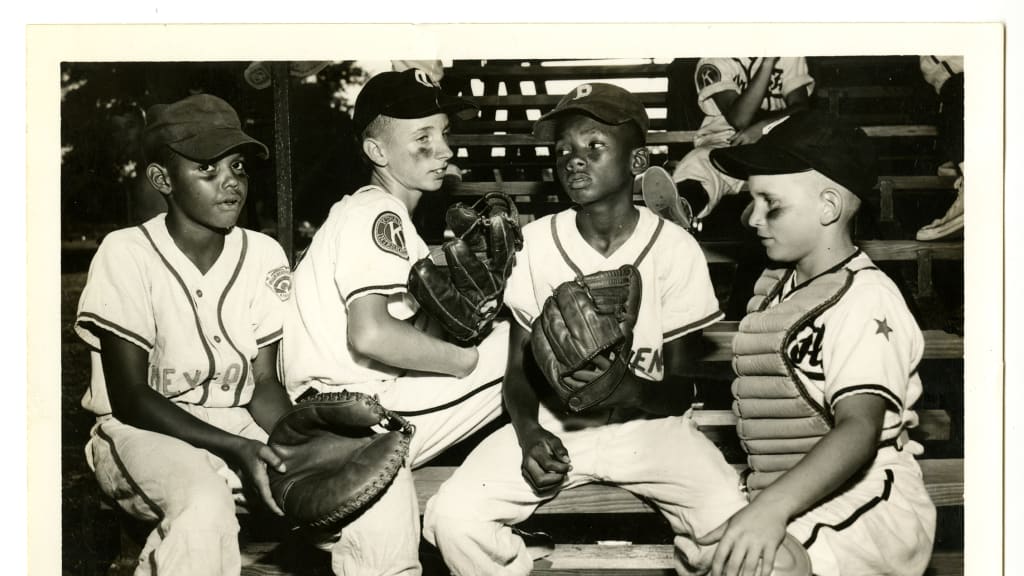
Decades passed.
Hall went into the Air Force and spent nearly 30 years with Hughes Supply, a large Orlando-based wholesaler of construction and industrial materials. Augustine eventually followed in the footsteps of his father and grandfather and became a man of the church. He has served as a pastor in Pensacola for more than 20 years.
But players on both sides of history never stopped wondering what became of their Little League opponents.
“That game has always been on my mind, and everything that was part of that game,” Augustine said.
Finally, after more than 60 years, there was a reunion.
It came in 2016 as part of a documentary film on the game, “Long Time Coming.” Thirteen members of the two teams – seven Kiwanis and six Jaycees – made their way to meet on a ballfield in Pensacola.
As the filmmakers got everything set up for the big moment, players in both dugouts – Jaycees on the first-base side, Kiwanis on the third-base side – didn’t know what to expect. It had been so long. What do you say? What do you do? When some Orlando players told the filmmakers they were nervous, they were told to not worry about it, because the Pensacola players feel the same way.
Action!
Both teams walked slowly out toward the pitcher’s mound.
“Something magical – or maybe spiritual – happened at that moment,” Hall recalled.
With hardly a word spoken, there was uproarious laughter. Huge hugs. Some tears. Sixty-one years melted away in the middle of a ballfield.
“It was as though we had known each other forever. Maybe it was because we shared one of the most unique experiences that a young kid, 12 years old, could experience. From that point forward, we felt as natural and as at ease as you could ever ask of your best friend,” said Hall.
Augustine remarked: “That was an awesome day.”
After the reunion, more jokes and memories were shared as the Kiwanis and Jaycees took up half of a nearby restaurant for lunch. Augustine told Johnny Lane, that huge force on the mound back in ‘55, that he looked much shorter 61 years later.
Hall said he joked with Pensacola players about how lonely he was at first base during the game, because he had no one to talk to.
Once it was time to leave, Augustine told the restaurant's owner how nice everything was and that he had done a good job. He added: “In 1955, this couldn’t happen.”
It was also during the filming of the documentary that Hall began to realize the true importance of that semifinal, and that it was indeed more than a baseball game. He also understood that his view of growing up in the 1950s was blind to the plight of those in the other dugout.
"I never really knew or understood what the Pensacola players had to endure," he said. "Even in Orlando, we just never had any socialization or contact with the Black community. There was no awareness of it. But having learned what I have learned, yes, we would say it was a dream time to grow up -- for us. But not for them."
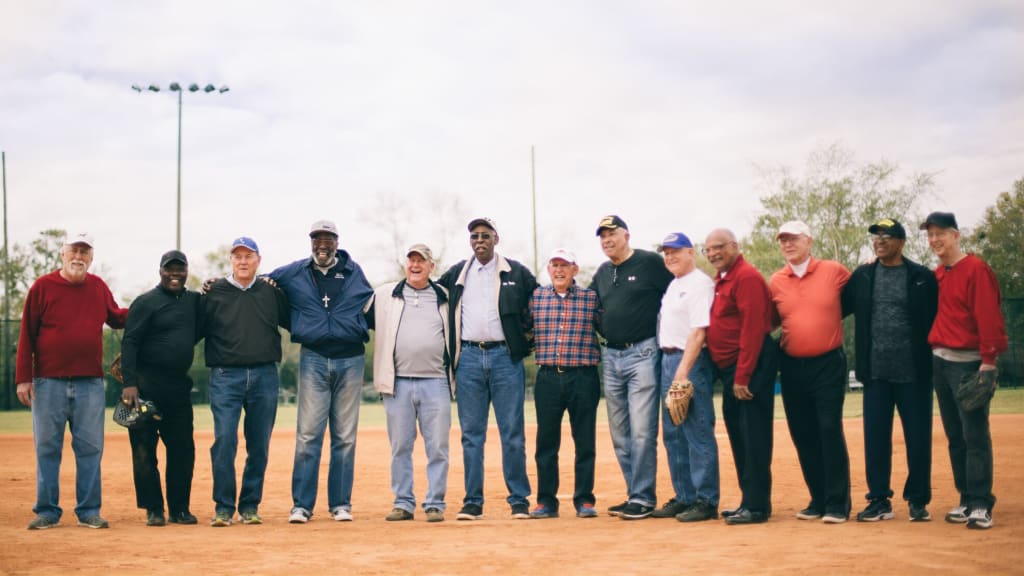
The 2018 release of the documentary breathed life into a largely forgotten tale of sports and racial equity.
It gave those players who traveled around the country to promote the film more unforgettable life experiences. Augustine, who was exhilarated to travel as a 12-year-old because of baseball, said the opportunities to visit places such as the Negro Leagues Baseball Museum in Kansas City and the Library of Congress “are worth millions of dollars.”
Hall’s most memorable moment on the promotional tour came during a trip to Washington D.C., where Hall of Famer Joe Morgan was set to join him and a Jaycees player for a private screening of the film. Hall accompanied Morgan to breakfast one morning during the trip and was uneasy about asking the two-time World Series champion to autograph a baseball.
But when Morgan happily offered to sign, Hall asked if he could personalize it. Morgan did.
To Stewart – You Made an Impact. Joe Morgan
But more than anything, the documentary quickly forged friendships throughout the teams that remain strong to this day. Hall and Augustine are close friends who call one another about every month. They reunited once again in March for the unveiling of "The Barrier Breakers” monument.
“That day, when I walked up to the monument and I saw it for the first time, honestly, I was just kind of overcome,” Hall said. “I’m glad I didn’t have to say a whole lot right there because I don’t think that I could have.”
More laughs. More hugs. More memories. When asked what he wants people to think when they stand in front of those two boys cast in bronze at Lake Lorna Doone Park, Augustine said: “When we really, really get together, when we find out that we both are human and we like the same things and we have the same color blood in us … then we can come to some kind of agreement.
“And hey, we can get along.”
